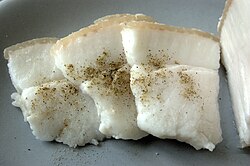Salo (food)
 Salo, sliced small and sprinkled with black pepper, usually it has a layer of meat | |

Salo (Ukrainian: сало, Russian: сало, Hungarian: szalonna, Polish: słonina, Romanian: slănină, Czech, Slovak: slanina, Carpatho-Rusyn: солонина/solonyna, Bosnian: slanina/сланина, Belarusian: сала, Lithuanian: lašiniai, Bulgarian: сланина, Serbian: slanina/сланина) is a traditional, predominantly Slavic food consisting of cured slabs of fatback (rarely pork belly), with or without skin (especially famous in Ukraine). The food is commonly eaten and known under different names in countries across the region. It is usually dry salt or brine cured. The East Slavic variety is sometimes treated with paprika or other seasonings, while the South Slavic version is often smoked. In Ukraine and many other countries salo is a part of the traditional national cuisine.
The Slavic word "salo" or "salanina" as applied to this type of food (it has other meanings as well) is often translated to English as "bacon" or "lard". Unlike lard, salo is not rendered. Unlike bacon, salo has little or no lean meat. It is similar to Italian lardo, the main differences being the thickness of the cut (lardo is often sliced very thinly) and seasoning. East Slavic salo uses salt, garlic, black pepper and sometimes coriander in the curing process, while lardo is generally seasoned with rosemary and other herbs.
Preservation[]
For preservation, salo is salted and sometimes also smoked and aged in a dark and cold place, where it will last for a year or more. The slabs of fat are first cut into manageable pieces, typically 15×20 cm. Then layers of fat slabs (skin side down) topped with one-centimetre layers of salt go into a wooden box or barrel for curing. For added flavouring and better preservation, the salo may be covered with a thick layer of paprika (usually in the more Western lands; in Russian salo with paprika is called "Hungarian"), minced garlic, or sometimes black pepper.[citation needed]
When salo has been aged too long or exposed to light, the fat may oxidize on the surface and become rancid, yellow and bitter-tasting. Though no longer fit for culinary use, the spoiled fat can be used as a water-repellent treatment for leather boots or bait for mouse traps, or it can simply be turned into homemade soap.[citation needed]
Culinary[]

This section does not cite any sources. (August 2021) |
Salo is consumed both raw and cooked. It is often fried or finely chopped with garlic as a condiment for borscht (beet soup). Small pieces of salo are added to some types of sausage. Thinly sliced salo on rye bread rubbed with garlic is a traditional snack to accompany vodka in Russia and horilka in Ukraine, where it is a particular favorite.
Salo is often chopped into small pieces and fried to render fat for cooking, while the remaining cracklings (shkvarky in Ukrainian, shkvarki in Russian, spirgai in Lithuanian, skwarki in Polish, škvarky in Czech, (o)škvarky in Slovak, jumări in Romanian, kõrned in Estonian, töpörtyű in Hungarian, пръжки or джумерки in Bulgarian) are used as condiments for fried potatoes or varenyky or spread on bread as a snack.
The thick pork skin that remains after the fat has been consumed is often used to make stock for soup or borscht. After boiling, the rind is often discarded. If soft enough, however, it is sometimes chopped or ground with salo, herbs, and spices and then spread on bread.
Salo in chocolate[]
The expression "chocolate-coated salo" (Сало в шоколаді, salo v shokoladi), originating in an ethnic joke about Ukrainians, has become cliché among Eastern Slavs, referring to an eclectic mix of tastes or desires, such as bacon ice cream.[citation needed]
In the 2000s, Odessa Confectionery Factory started production of candies Salo v Shokoladi.[1][2][3] The chocolate candies were invented as an April Fool's Day joke. They are not actually salo; they contain a regular caramel filling with a small amount of rendered fat added as a salty flavouring.[citation needed]
See also[]
References[]
| Wikimedia Commons has media related to Salo (food). |
- Slavic cuisine
- Animal fat products
- Cooking fats
- Charcuterie
- Smoked meat
- Pork
